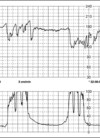fetal monitoring/search methods Flashcards
(53 cards)
EFM
electronic fetal monitoring
Why is continuous EFM controversial?
- It makes the laboring mother more sedentary. Not optimal for giving birth.
- It removes healthcare workers from the presence of mom, giving them a less complete picture of the overall condition of mom and baby.
- Provides less intensive care for laboring mothers and babies.
What is the best position for an electronic fetal monitor?
on the baby’s back
tocodynamometer
- device for monitoring and recording uterine contractions during labor
- has button on back
toco
contraction
ctx
contraction
tocolytic drug
drug that stops ctx
fetal monitor
- smooth on the back
- measures FHR
FHR
fetal heart rate
vibroacoustic stimulator
- device that uses sound waves and vibration to stimulate baby in utero
- used to elicit FHR accel and ensure fetal well-being
maternal-fetal unit
mom + uterus
↓
placenta
↓
cord + fetus
uteroplacental junction
- place where the placenta joins the uterus
- forms chambers where maternal blood collects
- nutrients and gases are exchanged through membrane of placental blood vessels lying in those chambers
- uterus and placenta are interwoven, almost like a zipper
umbilical cord
three blood vessels that carry fetal blood into and out of the uteroplacental junction for nutrient and gas exchange
AVA
- artery vein artery
- the three vessels that should be found in the umbilical cord
two-vessel umbilical cord
- can be indicative of genetic anomaly
- requires further investigation
What happens to the placenta and fetus during a normal ctx?
- placenta is squeezed, leaving less room for blood, and reducing gas and nutrient exchange
ctx → placenta compressed → less blood to cord → less blood to fetus - baby’s head is squeezed, sometimes eliciting a vagal response and lowering FHR (early decel)
What does a variable decel indicate?
cord compression
What does a late decel indicate?
uteroplacental insufficiency
What does an early decel mean?
baby’s head is squeezed during contraction, eliciting a vagal response and lowering FHR
What factors affect fetal oxygenation?
- normal maternal blood flow to placenta (volume)
- normal maternal SpO2
- functional placenta
- functional umbilical cord
- normal fetal circulation
interruptions to fetal SpO2
- changes in mom’s circulation
- drop in BP
- vena cava syndrome
- drop in maternal O2
- uterine activity
- placental problems
- umbilical cord problems
- abnormal fetal conditions
What causes drops in maternal O2?
- epidural: drop in BP; IV fluid bolus prophylactic
- vena cava syndrome: compression when supine; reposition mom
- smokers, lung conditions, anaphylaxis
What can cause placental insufficiency?
- small placenta
- blood clot in placenta
- part of placenta that doesn’t function
nuchal cord
- umbilical cord wrapped around baby’s neck
- doesn’t strangle baby
- compresses cord, ↓ O2 delivery




